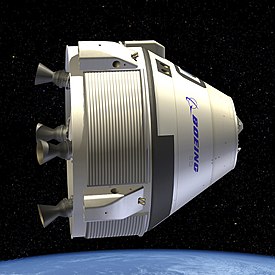CST-100

Rendering of the CST-100 Starliner
|
|
| Manufacturer | Boeing |
|---|---|
| Country of origin | United States |
| Operator |
Boeing Bigelow Aerospace |
| Applications | Crew Transfer Vehicle |
| Specifications | |
| Spacecraft type | Crewed capsule |
| Design life |
|
| Launch mass | 13,000 kg (29,000 lb) |
| Crew capacity | 7 |
| Dimensions |
|
| Volume | 11 m3 (390 cu ft) |
| Regime | Low Earth |
| Production | |
| Status | In development |
The CST-100 Starliner (Crew Space Transportation) crew capsule is a spacecraft design under construction by Boeing in collaboration with Bigelow Aerospace as their entry for NASA's Commercial Crew Development (CCDev) program. Its primary mission is to transport crew to the International Space Station and to private space stations such as the proposed Bigelow Aerospace Commercial Space Station.
It is similar to the Orion, a spacecraft being built for NASA by Lockheed Martin. The capsule has a diameter of 4.56 meters (15.0 ft), which is slightly larger than the Apollo command module and smaller than the Orion capsule. The Starliner is to support larger crews of up to seven people and is designed to be able to remain on-orbit for up to seven months with reusability of up to ten missions. It is to be compatible with multiple launch vehicles, including the Atlas V, Delta IV, and Falcon 9, as well as the planned Vulcan. The initial launch vehicle would be the Atlas V 422, launched from SLC-41 at Cape Canaveral Air Force Station, Florida.
In the first phase of its CCDev program NASA awarded Boeing US$18 million for preliminary development of the spacecraft. In the second phase Boeing was awarded $93 million for further development. On August 3, 2012, NASA announced the award of $460 million to Boeing to continue work on the CST-100 under the Commercial Crew Integrated Capability (CCiCap) Program. On September 16, 2014, NASA selected the CST-100, along with SpaceX's Dragon V2, for the Commercial Crew Transportation Capability (CCtCap) program, with an award of $4.2 billion. The spacecraft is expected to fly unmanned in June 2018, have a first crewed test flight in August 2018, and ferry two astronauts to the ISS for the first fully operational flight in December 2018.
...
Wikipedia
